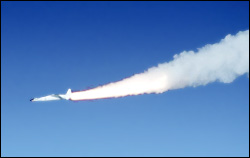NASA’s X-43A Scramjet Breaks Speed Record

Pegasus booster rocket ignites to send the X-43A on its record setting flight on Nov. 16, 2004. NASA photo <br>
X-43A research vehicle screamed into the record books again Tuesday, demonstrating an air-breathing engine can fly at nearly 10 times the speed of sound. Preliminary data from the scramjet-powered research vehicle show its revolutionary engine worked successfully at nearly Mach 9.8, or 7,000 mph, as it flew at about 110,000 feet.
The high-risk, high-payoff flight, originally scheduled for Nov. 15, took place in restricted airspace over the Pacific Ocean northwest of Los Angeles. The flight was the last and fastest of three unpiloted flight tests in NASA’s Hyper-X Program. The program’s purpose is to explore an alternative to rocket power for space access vehicles.
“This flight is a key milestone and a major step toward the future possibilities for producing boosters for sending large and critical payloads into space in a reliable, safe, inexpensive manner,” said NASA Administrator Sean O’Keefe. “These developments will also help us advance the Vision for Space Exploration, while helping to advance commercial aviation technology,” Administrator O’Keefe said.
Media Contact
More Information:
http://www.nasa.gov/missions/research/x43-main.htmlAll latest news from the category: Interdisciplinary Research
News and developments from the field of interdisciplinary research.
Among other topics, you can find stimulating reports and articles related to microsystems, emotions research, futures research and stratospheric research.
Newest articles

Superradiant atoms could push the boundaries of how precisely time can be measured
Superradiant atoms can help us measure time more precisely than ever. In a new study, researchers from the University of Copenhagen present a new method for measuring the time interval,…

Ion thermoelectric conversion devices for near room temperature
The electrode sheet of the thermoelectric device consists of ionic hydrogel, which is sandwiched between the electrodes to form, and the Prussian blue on the electrode undergoes a redox reaction…

Zap Energy achieves 37-million-degree temperatures in a compact device
New publication reports record electron temperatures for a small-scale, sheared-flow-stabilized Z-pinch fusion device. In the nine decades since humans first produced fusion reactions, only a few fusion technologies have demonstrated…





















